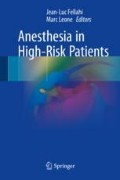Abstract
Patients suffering from end-stage renal disease (ESRD) are at high risk of surgery and perioperative complications. The renal disease has a global impact on the organism and creates significant disturbances to the metabolism, especially electrolyte disorders, excessive bleeding, fluid overload, heart failure and drug toxicity. Patients with ESRD may also have a remaining kidney function, which must be preserved during the perioperative period. The management of ESRD patients is based on three important steps. Firstly, evaluate the level of renal disease and its impact on patient conditions and comorbidities. Secondly, choose appropriate drugs and dosage while avoiding new renal insults that may impair the remaining kidney function or create metabolic disorders. Lastly, take care of fluid’s volume variations and electrolytes disturbances for each patient during all the perioperative time.
Access this chapter
Tax calculation will be finalised at checkout
Purchases are for personal use only
References
Stevens PE, Levin A, Kidney Disease: Improving Global Outcomes Chronic Kidney Disease Guideline Development Work Group Members. Evaluation and management of chronic kidney disease: synopsis of the kidney disease: improving global outcomes 2012 clinical practice guideline. Ann Intern Med. 2013;158:825–30.
Saran R, Li Y, Robinson B, Abbott KC, Agodoa LYC, Ayanian J, et al. US Renal Data System 2015 Annual Data Report: epidemiology of kidney disease in the United States. Am J Kidney Dis. 2016;67(3 Suppl 1):Svii–S1–305.
Cooper WA, O’Brien SM, Thourani VH, Guyton RA, Bridges CR, Szczech LA, et al. Impact of renal dysfunction on outcomes of coronary artery bypass surgery: results from the Society of Thoracic Surgeons National Adult Cardiac Database. Circulation. 2006;113(8):1063–70.
Holzmann M, Jernberg T, Szummer K, Sartipy U. Long-term cardiovascular outcomes in patients with chronic kidney disease undergoing coronary artery bypass graft surgery for acute coronary syndromes. J Am Heart Assoc. 2014;3(2):e000707–7.
Minakata K, Bando K, Tanaka S, Takanashi S, Konishi H, Miyamoto Y, et al. Preoperative chronic kidney disease as a strong predictor of postoperative infection and mortality after coronary artery bypass grafting. Circ J. 2014;78(9):2225–31.
Lautamäki A, Kiviniemi T, Biancari F, Airaksinen J, Juvonen T, Gunn J. Outcome after coronary artery bypass grafting and percutaneous coronary intervention in patients with stage 3b-5 chronic kidney disease. Eur J Cardiothorac Surg. 2016;49(3):926–30.
Pinson CW, Schuman ES, Gross GF, Schuman TA, Hayes JF. Surgery in long-term dialysis patients. Experience with more than 300 cases. Am J Surg. 1986;151(5):567–71.
Winkelmayer WC, Levin R, Avorn J. Chronic kidney disease as a risk factor for bleeding complications after coronary artery bypass surgery. Am J Kidney Dis. 2003;41(1):84–9.
Kasiske BL, Maclean JR, Snyder JJ. Acute myocardial infarction and kidney transplantation. J Am Soc Nephrol. 2006;17(3):900–7.
McClellan WM, Chertow GM. Beyond Framingham: cardiovascular risk profiling in ESRD. J Am Soc Nephrol. 2005;16(6):1539–41.
Charra B, Calemard M, Laurent G. Importance of treatment time and blood pressure control in achieving long-term survival on dialysis. Am J Nephrol. 1996;16(1):35–44.
Foley RN, Parfrey PS, Harnett JD, Kent GM, Murray DC, Barre PE. Impact of hypertension on cardiomyopathy, morbidity and mortality in end-stage renal disease. Kidney Int. 1996;49(5):1379–85.
Guarracino F, Baldassarri R, Priebe HJ. Revised ESC/ESA Guidelines on non-cardiac surgery: cardiovascular assessment and management. Implications for preoperative clinical evaluation. Minerva Anestesiol. 2015;81(2):226–33.
Kramer A, Pippias M, Stel VS, Bonthuis M, Abad Diez JM, Afentakis N, et al. Renal replacement therapy in Europe: a summary of the 2013 ERA-EDTA Registry Annual Report with a focus on diabetes mellitus. Clin Kidney J. 2016;9(3):457–69.
London GM, De Vernejoul MC, Fabiani F, Marchais SJ, Guerin AP, Metivier F, et al. Secondary hyperparathyroidism and cardiac hypertrophy in hemodialysis patients. Kidney Int. 1987;32(6):900–7.
de Mutsert R, Grootendorst DC, Axelsson J, Boeschoten EW, Krediet RT, Dekker FW, et al. Excess mortality due to interaction between protein-energy wasting, inflammation and cardiovascular disease in chronic dialysis patients. Nephrol Dial Transplant. 2008;23(9):2957–64.
Harnett JD, Kent GM, Foley RN, Parfrey PS. Cardiac function and hematocrit level. Am J Kidney Dis. 1995;25(4 Suppl 1):S3–7.
Abstract. Kidney Int Suppl (2011). 2012;2(4):282.
Ickx B, Cockshott ID, Barvais L, Byttebier G, De Pauw L, Vandesteene A, et al. Propofol infusion for induction and maintenance of anaesthesia in patients with end-stage renal disease. Br J Anaesth. 1998;81(6):854–60.
Shafer SL. Shock values. Anesthesiology. 2004;101(3):567–8.
Thapa S, Brull SJ. Succinylcholine-induced hyperkalemia in patients with renal failure: an old question revisited. Anesth Analg. 2000;91(1):237–41.
Cooper RA, Maddineni VR, Mirakhur RK, Wierda JM, Brady M, Fitzpatrick KT. Time course of neuromuscular effects and pharmacokinetics of rocuronium bromide (Org 9426) during isoflurane anaesthesia in patients with and without renal failure. Br J Anaesth. 1993;71(2):222–6.
Sparr HJ, Beaufort TM, Fuchs-Buder T. Newer neuromuscular blocking agents: how do they compare with established agents? Drugs. 2001;61(7):919–42.
Rocca Della G, Pompei L, Coccia C, Costa MG, Cecchini V, Vilardi V, et al. Atracurium, cisatracurium, vecuronium and rocuronium in patients with renal failure. Minerva Anestesiol. 2003;69(7-8):605. –11–612–5
Goldberg ME, Cantillo J, Larijani GE, Torjman M, Vekeman D, Schieren H. Sevoflurane versus isoflurane for maintenance of anesthesia: are serum inorganic fluoride ion concentrations of concern? Anesth Analg. 1996;82(6):1268–72.
Conzen PF, Kharasch ED, Czerner SFA, Artru AA, Reichle FM, Michalowski P, et al. Low-flow sevoflurane compared with low-flow isoflurane anesthesia in patients with stable renal insufficiency. Anesthesiology. 2002;97(3):578–84.
Gentz BA, Malan TP. Renal toxicity with sevoflurane: a storm in a teacup? Drugs. 2001;61(15):2155–62.
Liu LL, Gropper MA. Postoperative analgesia and sedation in the adult intensive care unit: a guide to drug selection. Drugs. 2003;63:755–67.
Author information
Authors and Affiliations
Corresponding author
Editor information
Editors and Affiliations
Rights and permissions
Copyright information
© 2018 Springer International Publishing AG
About this chapter
Cite this chapter
Dewitte, A., Joannès-Boyau, O. (2018). The Patient with End-Stage Renal Disease. In: Fellahi, JL., Leone, M. (eds) Anesthesia in High-Risk Patients. Springer, Cham. https://doi.org/10.1007/978-3-319-60804-4_10
Download citation
DOI: https://doi.org/10.1007/978-3-319-60804-4_10
Published:
Publisher Name: Springer, Cham
Print ISBN: 978-3-319-60803-7
Online ISBN: 978-3-319-60804-4
eBook Packages: MedicineMedicine (R0)

